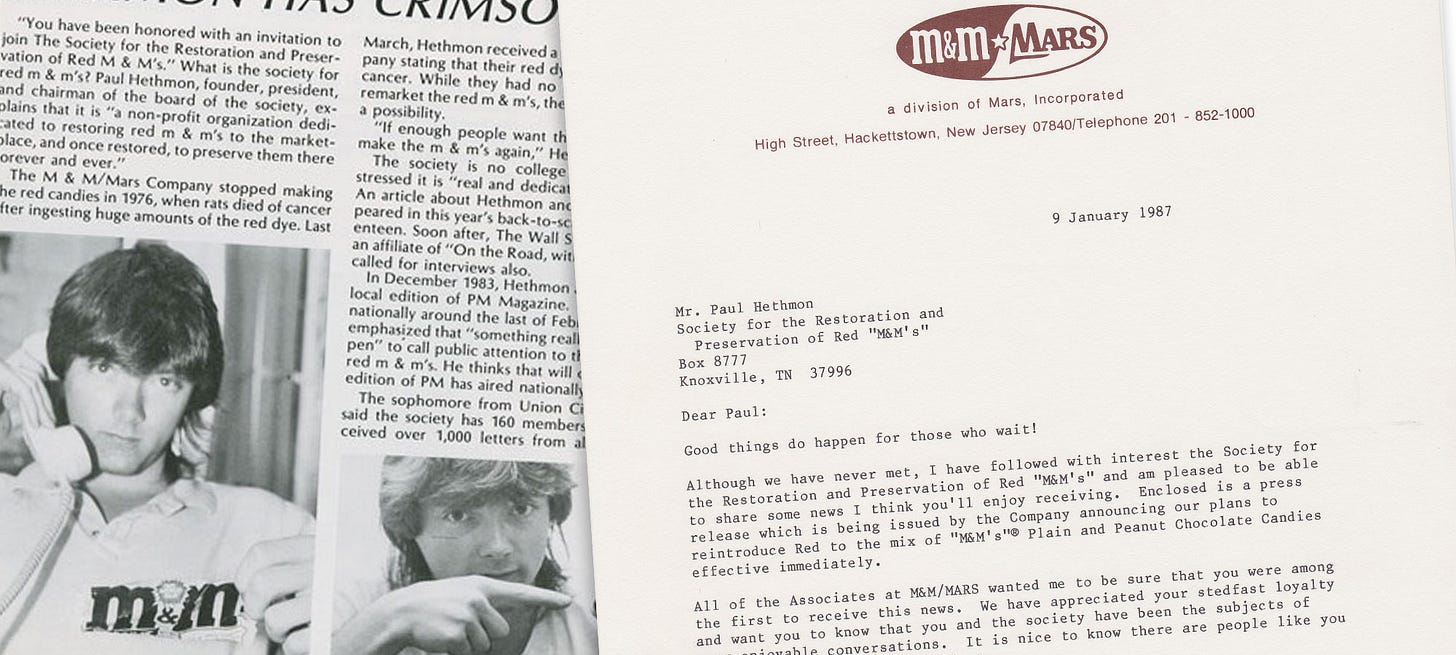Food Dyes: Red Flags Are Everywhere
And the story of how I helped bring back the red M&M in 1985.
In 1985, Paul Hethman, a University of Tenessee college student, decided to fight the battle of red dyes, and I decided to join him.
But I wasn’t fighting against them; I was fighting for them. I joined what he named the “Society for the Preservation and Restoration of the Red M&M.” I gladly added my name to a long list of others who were distraught over the thought of losing the best-tasting M&M, in my opinion - the red one. Honestly, I had no idea what I was doing; I just thought it was funny, and so did thousands of others.
But it worked - Paul Hethmon and his groupies had a red hand in reversing the removal of the dye in red M&Ms. (I’m not proud of this, just to be clear. :/ )
The Mars company had decided to stop red M&Ms from being in the colorful lineup due to concerns about red dye. This was back in 1985, mind you. Little did I know this was a harbinger of the dye debates that would resurface decades later.
Fast forward to 2025, and here we are: red dye is once again under fire, now part of RFK’s and MAHA’s mission to “Make America Healthy Again.” But this time, it’s not just about candy—it’s about what these synthetic colorants do to our health. Europe banned some of these dyes years ago. Why are we only now getting worked up about it? It’s been an issue for a while - going back to earlier than 1985, but we just didn’t realize it.
Food Dyes: Coloring Outside the Lines
Let’s start with the basics. Food dyes like Red 40, Blue 1, and Yellow 5 are synthetic colorants derived from petroleum. Yes, the same stuff that fuels your car is also coloring your favorite fruity cereal. These dyes serve no nutritional purpose—they’re just there to make food look “fun.” Think bright red gummy bears, neon orange cheese puffs, or rainbow-colored drinks.
But here’s the health kicker: food dye rarely travels solo. It usually comes with added sugars, preservatives, or other artificial ingredients. That fruit punch with Red 40? It’s a sugar bomb in disguise. Those fluorescent cupcakes? Packed with high fructose corn syrup.
The problem isn’t just the dye—it’s the package deal. If you’re looking for foods to eliminate from your diet, red dye is practically a beacon signaling, “Hey, this food is probably not great for you!”
The Red Scare: Are Food Dyes Actually Harmful?
So, what’s the big deal? Studies suggest that certain dyes, particularly Red 40, may contribute to hyperactivity in children and potentially trigger allergic reactions. Kids seem more susceptible to these effects because their bodies and brains are still developing, and cells are still dividing rapidly. This is a susceptible time in a person’s life for cell damage. Some research even links artificial dyes to behavioral issues in children predisposed to ADHD. Article links are below if you’re curious.
Europe took these concerns seriously, banning several dyes or slapping warning labels on foods that contain them. Meanwhile, in the U.S., the FDA has declared them “safe” in small amounts. But how small is small? If your child’s breakfast cereal, mid-morning snack, lunch drink, and after-school treat all contain dye, those “small amounts” start adding up.
Will an Occasional Red Snack Doom You?
Let’s not panic. One red lollipop isn’t going to derail your child’s health or send them bouncing off the walls. The real issue is the cumulative effect. A diet loaded with dyed, processed foods—many of which are already high in sugar and preservatives—can have long-term consequences.
As adults, we’re the gatekeepers to our kid’s nutritional intake. Kids don’t have the judgment to say no to neon blue slushies, but we do. Teaching them to enjoy naturally colored foods, like the vibrant orange of a sweet potato or the deep red of a strawberry, sets them up for healthier habits later. I’m sure my adult children can still recall when I said blue food is unnatural, so “no” to blue food, period.
Think First, Respond Second
This isn’t about hysteria or declaring war on your kid’s favorite snacks. It’s about awareness. Food dyes are part of a bigger picture that includes sugar, preservatives, and overall dietary patterns. Instead of focusing on just one ingredient, think about what’s around that ingredient.
Here’s a simple strategy:
Read labels. If you see artificial dyes, chances are the product has other unnecessary additives, too.
Choose naturally colored foods. Fruits, vegetables, and minimally processed snacks don’t need dyes to look appealing.
Teach your kids about food. Help them understand why bright red candy isn’t as great as real red apples, cherries, and watermelon.
And finally, let’s all take a breath. Occasional treats are fine. But if your weekly grocery haul looks like a rainbow exploded, it might be time to rethink your choices.
Knowledge is Power Over Your Health
Looking back, my teenage self was rallying for the wrong thing. The disappearance of red M&Ms wasn’t a tragedy; it was a lesson I missed. Today, as we confront the health impacts of food dyes and similar challenges, I hope this information leaves you feeling wiser and more empowered to take control of your health because you are in more control over your health than you think.
References for Curious Minds
What are your thoughts on the red food dye ban? Were you, too, a wayward part of the preservation committee of the red M&M? Sound off in the comments and I’ll see you next week!
In good health,
Dr. Alice Burron
A little more about Dr. Alice Burron and The Health Navigator Group:
Check out our website!
Catch us on Instagram: @the.health.navigator and @dr_burron
You can also connect on LinkedIn, if you want to be professional about it. 👓
And if you’re not subscribed to Health Shift here on Substack — it’s time! This letter is completely free and packed with useful tools to help you on your journey to better, faster healing.











